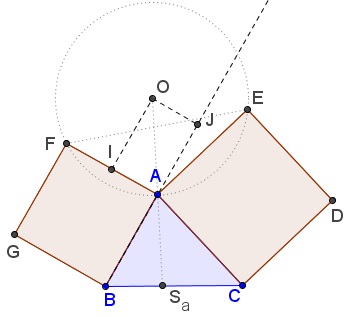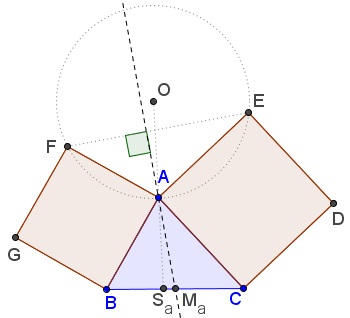Symmedian via Squares and a Circle
Form squares $ABGF\;$ and $ACDE\;$ in the exterior of $\Delta ABC.\;$ Let $O\;$ be the center of circle $(AEF),\;$ as shown

Then that the line $OA\;$ is the symmedian in $\Delta ABC\;$ through vertex $A.$
Proof 1
The distance from $O\;$ to $AB\;$ equals $\displaystyle d(O,AB)=OJ=\frac{1}{2}AF=\frac{1}{2}AB:$

Similarly the distance $\displaystyle d(O,AC)=\frac{1}{2}AC.\;$ It follows that $\displaystyle \frac{d(O,AB)}{d(O,AC)}=\frac{AB}{AC}\;$ which is one of the characteristic properties of the symmedian.
Proof 2
The configuration of two squares on the sides of a triangle is a part of the well known Bride's Chair; $\Delta AEF\;$ is a flank triangle of $\Delta ABC.\;$ The altitude through $A\;$ in the former is the median through $A\;$ in the latter:

It is also true that angles $BAC\;$ and $EAF\;$ share the angle bisector. On the other hand, in $\Delta AEF\;$ the orthocenter and the circumcenter are isogonal conjugate, implying that the altitude through $A\;$ is isogonal to $AO.\;$ Thus, in $\Delta ABC,\;$ the line $AO\;$ is isogonal to the median $AM_a\;$ and, therefore, is the symmedian through $A.$
References
- Sammy Luo and Cosmin Pohoata, Let's Talk About Symmedians!, Mathematical Reflections 4 (2013), 1-11
![]()
Symmedian
- All about Symmedians
- Symmedian and Antiparallel
- Symmedian and 2 Antiparallels
- Symmedian in a Right Triangle
- Nobbs' Points and Gergonne Line
- Three Tangents Theorem
- A Tangent in Concurrency
- Symmedian and the Tangents
- Ceva's Theorem
- Bride's Chair
- Star of David
- Concyclic Circumcenters: A Dynamic View
- Concyclic Circumcenters: A Sequel
- Steiner's Ratio Theorem
- Symmedian via Squares and a Circle
- Symmedian via Parallel Transversal and Two Circles
- Symmedian and the Simson
- Characterization of the Symmedian Point with Medians and Orthic Triangle
- A Special Triangle with a Line Through the Lemoine Point
![]()
|Contact| |Front page| |Contents| |Geometry|
Copyright © 1996-2018 Alexander Bogomolny
73505099
